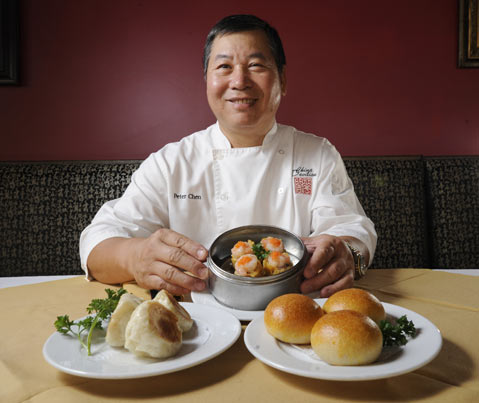Dumplings: A Theoretical Approach
How Peter Suy Chen Brought Dim Sum to Santa Barbara

Not long ago, my son Zac floated a theory about food. “People love protein wrapped in carbohydrates,” he proclaimed (and I boldly paraphrase), “which explains why people love tacos, ravioli, sandwiches, and dim sum.”
As usual, my genius offspring is right on both the mega- and the small-plate level. One of the great pleasures of inhabiting this planet is the Chinese version of protein-wrapped delectables with a wide array of centers: ground chicken, tofu, gelatinized pork stock, shrimp, and even lobster enveloped in smooth carbs like wonton skins, delicate rice noodles, leavened and steamed dough, and sticky rice. The dumplings and buns also include bold flavor enhancers: spices both raw and dried, soy, ginger, chili, and even ground peanut flurries.
They are small and easily devoured: Pluck a flavorful gem from a steaming tray, pop it in your ravioli hole, then follow with many more in any order, elevating the act of ingestion from routine nutritional pursuit to affordable midday feast. (Dim sum, like mogwai, should not come out at night.) And they are equally good with tea or fine wines, says Peter Suy Chen, who ought to know since he collects California and French wines and brought dim sum to downtown Santa Barbara’s China Pavilion five years ago.
His dim sum experiment is flourishing. “We started it because weekends were so slow; all the office people who come for lunch were gone,” said Chen, who owns and loves to cook at his place on the fashionable corner of Anapumu and Chapala. Chen was born in Taiwan and arrived on this shore via Bolivia and Monterey Park 11 years ago, but dim sum is his big win. “We said why not, and it just keeps growing,” he said. “It’s catching on, and I think a lot of Chinese students are here now. They want someplace to go.”
Weekend brunches have become crazy popular. “The kitchen gets very busy,” he said. “We make most everything right after it’s ordered.” Chen uses a checklist approach rather than the traditional dim sum serving method, which involves women driving steaming carts of food offering new morsels constantly. “I had a hard time finding women who could serve the food and who speak English,” Chen explained. “Most of the women working in big-city restaurants speak only Chinese. And besides, you need more space,” he said gesturing around the lovely but confined quarters of China Pavilion.
By the way, Chen has his own food theory. It’s about dim sum, and it’s more like a charming origin story. “Old people always wake up early,” said Chen. “And there’s not much for them to do. So they call their friends up for a pot of tea. And maybe something to eat. Maybe they’re not even hungry, but they want little dishes. They chat with their friends, drink tea, and eat small dishes for hours. That’s what dim sum is.”
There’s another thing that dim sum is: not always protein wrapped in carbohydrates. There are chicken feet, for instance. “You know, they are good,” said Chen who is frankly perplexed by Western squeamishness. “We don’t think they look weird. People eat pig’s feet.”
But even more than that, dim sum is adaptable. Chen invented new dishes like lychee fruit with shrimp — exquisite. “But I also make vegetarian dim sum,” he said. “My wife and her mother are vegetarians. So I made dishes for them to enjoy.”
4∙1∙1
Enjoy dim sum for yourself on the weekends at China Pavilion (1202 Chapala St.). See china-pavilion.com or call (805) 560-6028.



